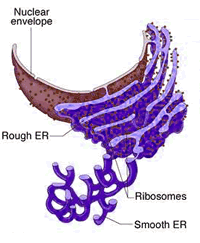Cell Structures
The Nucleus
- nuclear envelope contains nuclear pores for some things to enter and exit (nucleoplasm within)
- chromatin is DNA and proteins, when the cell begins to divide, chromatin condenses and forms chromosomes
- DNA remains in the nucleus, it sends instructions to the cytoplasm via messenger RNA
- RNA directs the synthesis of proteins on ribosomes in the cytoplasm
- Nucleolus assembles ribosomes within the nucleus, ribosomes contain the "tools" to construct proteins
Endoplasmic Reticulum -- Transport System
(endoplasm means "within cytoplasm", reticulum means "little net"
--divides cell into compartments
--channels molecules through the cell's interior, like a little highway
Rough ER
--has ribosomes which give it its "rough" appearance
--functions in protein synthesis
--ER transports newly assembled proteins to the Golgi Apparatus
Smooth ER
--mostly contains enzymes that unction in lipid synthesis (such as hormones like estrogen and testosterone)
Golgi Apparatus -- Delivery System
- flattened stacks of membranes
- functions in collection, packaging and distribution of molecules made in the cell and used elsewhere
- front end (cis) faces the ER, and the back end (trans) faces the cell membrane
--the folded stacks are called cisternae - unprocessed proteins enter the Golgi apparatus from ER
proteins are packaged and exported near membrane
Jobs of the Golgi Apparatus (aka Golgi Complex)
- separates proteins according to their destinations
- modifies proteins (adds sugar and makes glycoproteins)
- packages materials into vesicles which are exported outside the cell - secretion
Lysosomes - Intracellular Digestion Centers
- vesicles that are used to digest
- contain high levels of degrading enzymes (to "lyse" means to dissolve)
- recycle old and worn out cell parts
- "suicide sac" - apoptosis
- digest other particles taken in by phagocytosis
- -this "food" is stored in food vacuoles, the lysosomes fuse with the vacuoles and release digestive enzymes
- found in animal cells
TAY-SACHS disease – missing an enzyme of the lysosomes that breaks down a fatty substance. Over time this fat builds up in the brain and nervous tissue, smothering the cells. Results in degeneration and death.
Ribosomes - Sites of Protein Synthesis

--each is composed of two subunits, one large and one small
--mRNA is "read" by the ribosomes and amino acids are assembled into proteins
--ribosomes are manufactured by the nucleolus inside the nucleus
--polyribosomes – strings of ribosomes in the cytoplasm that work to make a protein
Other Organelles
-- Peroxisomes – result in hydrogen peroxide, broken down by catalase
-- Vacuole -- mainly storage or specific functions (contractile vacuole)
-- Plant cells have a CENTRAL VACUOLE - used for storage and help to maintain hydrostatic pressure

Image by brgfx on Freepik
ENERGY RELATED ORGANELLES
Mitochondria - The Cell's Chemical Furnaces
--contains its own DNA, support for Endosymbiosis Theory
--singular is "mitochondrion"
--2 membranes, one smooth outer membrane, and an inner membrane folded into layers called cristae
--Cristae has two compartments: the matrix and the intermembrane space
--mitochondria divide before cell division, they are not synthesized like other cell parts
--function to store energy for cell use. Energy is stored in the form of ATP - adenosine triphosphate

Chloroplasts - Where Photosynthesis Takes Place

--only found in plant cells
--has its own DNA, like mitochondrion
--functions to convert light energy to carbohydrates
--carbohydrates then broken down in mitochondria to produce ATP
--consists of grana, closed compartments that are stacked
--thylakoids are the individual disk shaped compartments that make up the grana (stack of thylakoids)
--stroma is the fluid surrounded the thylakoids
*Chloroplasts are a type of plastid
Chromoplasts – red, yellow and orange pigment
Leucoplasts – colorless (potatoes)
Cytoskeleton - Support System
- Microfilaments (now called actin filaments) – occur in bundles, form tracks within the cell for the movement of organelles, used to form pseudopods (ameba)
- Intermediate filaments - support membrane, cell to cell junctions
- Microtubules - (little pipe) – regulated by the MTOC (microtubule organizing center), radiate from the centrosome - form the spindle during cell division
- Centrioles – used during cell division to move and separate chromosomes, only found in animal cell



 Related to Movement
Related to Movement
Pseudopod – extensions of the cell that allow for movement (ameba), depend on actin filaments
Cilia (hair)
Flagella (whip)
--function in movement
-- 9+ 2 Arrangement of microtubules


